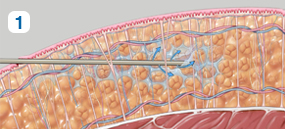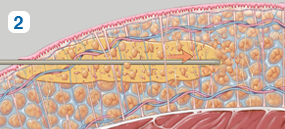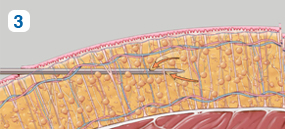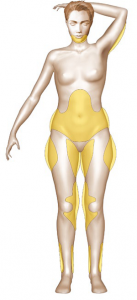The aim of this document is to give you all the essential information you need in order to make an informed decision, with full knowledge of the facts related to this procedure. Consequently, we strongly advise you to read it carefully.
Principles
Vaser Hi Def (VHD) Liposculpturing can radically and definitively diminish localized areas of protruding fat. These localized areas of protruding fat do not go away with strict diet and exercise. Conversely, lipo-sculpturing is not a method for losing or controlling weight. It is a method to defined better the body curve that is cover with some extra resistant fat to diet & gym. Lipo-sculpturing is not a treatment for obesity.
The principle of lipo-sculpturing is to remove fat through very small skin incisions, with atraumatic and blunt-tipped cannulas. These cannulas are attached to a closed negative pressure system, which permits safe and sterile aspiration of excessive fat cells.
How Vaser Hi Def Works?
The Science Behind the Art
VASER HI DEF produces superior results by treating areas of fat with ultrasound energy, then gently removing the fat through a small tube inserted under the skin. This minimally invasive process is gentle on the body and supremely effective, giving patients the smooth contours they want with far less pain or recovery, less swelling & bruises than traditional liposuction.
Understanding VASER
VASER uses a minimally invasive liposuction technique that selectively breaks apart and gently removes unwanted fat.
- The targeted area is injected with a special saline solution (tumescent fluid) to numb the area and shrink local blood vessels. It also temporarily expands the volume of the target area, making fat cells easier to remove.
- Small probes are then inserted into the body through small incisions. These probes resonate at a high ultrasound frequency, shaking fat cells loose while leaving most of surrounding tissues intact.
- The loose fat cells mix with the tumescent fluid, and are then removed from the body using special cannulas which help preserve the tissue matrix.
 Infiltration The fatty layer is injected with tumescent fluld. |
 Ultrasound Delivery VASERlipo ultrasound probes cause the fat cells to shake apart and combine with the tumescent fluid. |
 Aspiration Loose fat is easily removed via specially designed suction tubes. |
 Skin Retraction During the healing process, skin will retract to give smooth, natural-looking results. |
Practically, lipo-sclupturing can be applied to numerous body areas: hips, thighs, abdomen, waist, flanks, back, knees, calves, ankles and upper arms. .
Recent progress in the field of superficial liposuction, performed with very thin cannulas have reduced skin trauma or bruising. It has even improved the final result by enhancing skin shrinkage, when performed with great attention and skill. Meanwhile, it must be kept in mind that liposuction, however common a procedure it has become, remains a genuine surgical intervention, that ought to be performed by a skilled and qualified Plastic Surgeon, specially trained for this technique, in a truly surgical environment.
 |
 |
Before The Operation
A preoperative check-up is made following your surgeon’s recommendations.
The anesthesiologist will be seen in consultation prior to surgery.
No medication containing aspirin will be taken for 10 days before surgery & 3 days after surgery.
According to the type of anesthesia chosen, you may be asked not eat or drink for 6 hours before surgery.
Stop smoking is recommended at least one month before and 6 weeks after the intervention (smoking can cause a delay or bad healing & others).
Type of Anesthesia
Lipo-sculpturing can be performed, depending on the amount of areas to be treated, either under local anesthesia, local anesthesia associated with intravenous sedation or general anesthesia. In some cases, regional anesthetics, such as an epidural.
The type of anesthesia will be chosen after a discussion between yourself, your surgeon and your anesthesiologist.
The Procedure
Every surgeon has his or her personal technical habits which he or she adapts to every new case, in order to obtain the best possible results. However, there are common principles:
Skin incisions are small (3 to 4 millimeters) and discrete, usually hidden in a natural fold. Fat cells from deep and superficial fat layers are aspirated through smooth cannulas tunneled though subcutaneous tissue layers, taking care to avoid nerves and blood vessels.
The amount of fat removed is adapted to the amount of the overlying skin, which represents a fundamental factor for the quality of the final result. The amount should not exceed 6% of the weight & in all cases not more than 5 Liters to avoid excessive bleeding & serious complications.
The duration of the procedure depends on the amount of fat removed and on the number of body areas to treat. It can vary from 30 minutes to 3 hours (average time is 1 to 2 hours).
After The Operation
The necessary time needed to recover from surgery is proportional to the amount of excess fat removed.
After surgery, you will observe swelling and bruising in the treated areas.
Pain can vary from one patient to another, but it is usually mild, due to the use of very thin cannulas.
Fatigue is common in the first few post-operative days.
You can go back to your usual activity 4 to 7 days after surgery, again depending on the extent of your liposuction and your type of professional activity.
Bruising usually disappears 3-4 weeks after surgery.
It is strongly recommended to wear a pressure garment for 1 month 24 hours.
It is possible to start sports again 3 weeks after surgery.
There is a noticeable improvement of body contour in the first 2 to 3 weeks, inspite of the tissue swelling (edema) in the operated areas.
It is only after 3-4 weeks and with the reducing of this edema that results will begin to appear. The skin will retract completely in 6-12 months over the new contours and readapt the new silhouette.
The Result
The final result can be best appreciated 6-12 months after the procedure. It is most satisfactory when the patient selection and technique are properly done, permitting removal of localized fat deposits and producing skin retraction.
Disappointing Result
It has already been explained how liposuction, when correctly indicated and performed, can offer a real improvement to patients in terms of satisfying results and conformity to their expectations.
In some cases, localized imperfections can be observed, which must be distinguished from genuine complications: insufficient corrections, residual asymmetry, surface irregularities. These can be corrected secondarily under local or general anesthesia after 6 months.
Possible Complications
Lipo-sculpturing, even if performed for aesthetic reasons, is a genuine surgical procedure, with the consequent risks related to all medical acts, no matter how mild they might appear.
There are surgical and aesthetic complications.
Concerning anesthesia, the anesthesiologist will inform you about all the anesthetic risks. You must be aware that anesthesia can sometimes cause unpredictable body reactions that can be difficult to control. The presence of an experienced anesthesiologist, in a surgical environment, means that the risks are statistically practically negligible.
In fact, techniques, products and monitoring methods have progressed considerably over the last twenty years, offering optimal safety, especially when the operation is elective and the patient is in good general health.
Concerning surgery: by choosing a competent and qualified Plastic Surgeon, experienced in performing this procedure, you limit, but do not entirely eliminate, surgical risks.
Among possible complications, you must be aware of the following:
• Thrombo-embolic accidents (blood clot in the veins of the legs, pulmonary embolism) are rare, but can be life-threatening. They can be prevented by strict prophylactic measures, such as standing and walking as soon as possible after surgery, wearing compression stockings, or heparin therapy (low doses of heparin injected under the skin)
• Blood clots (haematomas) are quiet rare but can occur. They can be evacuated to prevent an impairment of the final aesthetic result.
• Infection, though common, can be treated with drainage and antibiotics.
• Toxic shock syndrome: rare cases of this have been reported.
• It is rare to notice lymph collection or seroma accumulating under the skin. Such a collection can be drained and will dry up rapidly without sequela.
• Localised skin necrosis. Large areas of necrosis are rare. They can be prevented by a proper surgical examination and a cautious and well-executed operation.
• Numbness of skin may be observed, frequently. It is usually transient and most patients recover normal skin sensation after 3 to 12 months.
Resistant swelling & fibrotic tissues accumulation can be improved by sessions of Manual Lymphatic Drainage MLD by a professional physiotherapist or LPG sessions.
These are the facts which we wish to bring to your attention, to complement what you were told during the consultation.
Our advice is for you to keep this document and to read it and think it over carefully after your consultation.
Once you have done this you will perhaps have further queries, or require additional information.
We are at your disposal should you wish to ask questions during your next consultation, or by telephone, or even on the day of the operation, when we will meet in any case, before the anesthesia.
IMPORTANT NOTE:
To preserve the final result of the surgery, the patient should keep his weight stable because gaining weight will appear in the other non-operated areas then with more extra weight in the same operated areas may be smaller or differently, BE CAREFUL.
EAT HEALTHY & DO GYM ALWAYS & FOR EVER.

